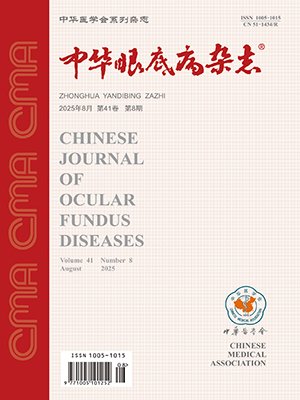| 1. |
Heiden D, Saranchuk P, Tun N, et al. We urge WHO to act on cytomegalovirus retinitis[J]. Lancet Glob Health, 2014, 2(2): 76-77. DOI: 10.1016/S2214-109X(13)70174-8.
|
| 2. |
Ford N, Shubber Z, Saranchuk P, et al. Burden of HIV-related cytomegalovirus retinitis in resource-limited settings: a systematic review[J]. Clin Infect Dis, 2013, 57(9): 1351-1361. DOI: 10.1093/cid/cit494.
|
| 3. |
中华医学会感染病学分会艾滋病丙型肝炎学组, 中国疾病预防与控制中心. 中国艾滋病诊疗指南(2018版)[J]. 传染病信息, 2018, 31(6): 481-499, 504. DOI: 10.3969/j.issn.1007-8134.2018.06.001.AIDS and Hepatitis C Professional Group, Society of Infectious Diseases, Chinese Medical Association; Chinese Center for Disease Control and Prevention. Chinese guidelines for diagnosis and treatment of HIV/AIDS (2018)[J]. Infect Dis Info, 2018, 31(6): 481-499, 504. DOI: 10.3969/j.issn.1007-8134.2018.06.001.
|
| 4. |
Holland GN, Van Natta ML, Goldenberg DT, et al. Relationship between opacity of cytomegalovirus retinitis lesion borders and severity of immunodeficiency among people with AIDS[J]. Invest Ophthalmol Vis Sci, 2019, 60(6): 1853-1862. DOI: 10.1167/iovs.18-26517.
|
| 5. |
Chiotan C, Radu L, Serban R, et al. Cytomegalovirus retinitis in HIV/AIDS patients[J]. J Med Life, 2014, 7(2): 237-240.
|
| 6. |
Port AD, Alabi RO, Koenig L, et al. Cytomegalovirus retinitis in the post-cART era[J]. Curr Ophthalmol Rep, 2018, 6(2): 133-144. DOI: 10.1007/s40135-018-0173-4.
|
| 7. |
朱雪菲, 陆云峰, 陆培荣, 等. 白血病患者巨细胞病毒性视网膜炎的临床特点和疗效观察[J]. 中华眼底病杂志, 2018, 34(1): 43-46. DOI: 10.3760/cma.j.issn.1005-1015.2018.01.011.Zhu XF, Lu YF, Lu PY, et al. Clinical characteristics and treatment of cytomegalovirus retinitis in leukemia[J]. Chin J Ocul Fundus Dis, 2018, 34(1): 43-46. DOI: 10.3760/cma.j.issn.1005-1015.2018.01.011.
|
| 8. |
Vannozzi L, Bacherini D, Sodi A, et al. Cytomegalovirus retinitis following intravitreal dexamethasone implant in a patient with central retinal vein occlusion[J]. Acta Ophthalmol, 2016, 94(2): 158-160. DOI: 10.1111/aos.12783.
|
| 9. |
Dogra M, Rohilla V, Dogra M, et al. Macular cytomegalovirus retinitis following dexamethasone intravitreal implant combined with phacoemulsification[J]. Indian J Ophthalmol, 2018, 66(9): 1361-1363. DOI: 10.4103/ijo.IJO_171_18.
|
| 10. |
Bae SH, Kim TW, Chung H, et al. Cytomegalovirus retinitis after intravitreal bevacizumab injection in an immunocompetent patient[J]. Korean J Ophthalmol, 2013, 27(1): 61-63. DOI: 10.3341/kjo.2013.27.1.61.
|
| 11. |
Yashiro S, Nishijima T, Yamamoto Y, et al. Spectral domain optical coherence tomography and fundus autofluorescence findings in cytomegalovirus retinitis in HIV-infected patients[J]. Jpn J Ophthalmol, 2018, 62(3): 373-389. DOI: 10.1007/s10384-018-0574-9.
|
| 12. |
Ruiz-Cruz M, Alvarado-de LBC, Ablanedo-Terrazas Y, et al. Proposed clinical case definition for cytomegalovirus-immune recovery retinitis[J]. Clin Infect Dis, 2014, 59(2): 298-303. DOI: 10.1093/cid/ciu291.
|
| 13. |
刘骏杰, 黄宝宇, 卢淑文, 等. 获得性免疫缺陷综合征合并巨细胞病毒性霜样树枝状视网膜血管炎一例[J]. 中华眼底病杂志, 2016, 32(5): 540-542. DOI: 10.3760/cma.j.issn.1005-1015.2016.05.023.Liu JJ, Huang BY, Lu SW, et al. A case of acquired immune deficiency syndrome with cytomegalovirus frosted branch angiitis[J]. Chin J Ocul Fundus Dis, 2016, 32(5): 540-542. DOI: 10.3760/cma.j.issn.1005-1015.2016.05.023.
|
| 14. |
孙挥宇, 李丹, 毛菲菲, 等. 获得性免疫缺陷综合征合并巨细胞病毒性视网膜炎的特殊眼底病变特征[J]. 中华眼底病杂志, 2014, 30(3): 309-311. DOI: 10.3760/cma.j.issn.1005-1015.2014.03.020.Sun HY, Li D, Mao FF, et al. Characteristics of special fundus lesions in acquired immune deficiency syndrome with cytomegalovirus retinitis[J]. Chin J Ocul Fundus Dis, 2014, 30(3): 309-311. DOI: 10.3760/cma.j.issn.1005-1015.2014.03.020.
|
| 15. |
Grossniklaus HE, Frank KE, Tomsak RL. Cytomegalovirus retinitis and optic neuritis in acquired immune deficiency syndrome: report of a case[J]. Ophthalmology, 1987, 94(12): 1601-1604. DOI: 10.1016/s0161-6420(87)33261-0.
|
| 16. |
Alexander SI, James B, Peggy F. Juxtapapillary cytomegalovirus retinitis with optic neuritis[J]. J Neuroophthalmol, 2008, 28(2): 128-130. DOI: 10.1097/WNO.0b013e3181782e52.
|
| 17. |
Mansor AM, Li HK. Cytomegalovirus optic neuritis: characteristics, therapy and survival[J]. Ophthalmologica, 1995, 209(5): 260-266. DOI: 10.1159/000310627.
|
| 18. |
Aguilar LLA, Gonzalez DA. Frosted branch angiitis associated with cytomegalovirus retinitis[J]. Ophthalmology, 2016, 123(3): 645. DOI: 10.1016/j.ophtha.2016.01.015.
|
| 19. |
Biswas J, Raizada S, Gopal L, et al. Bilateral frosted branch angiitis and cytomegalovirus retinitis in acquired immunodeficiency syndrome[J]. Indian J Ophthalmol, 1999, 47(3): 195-197.
|
| 20. |
Walker S, Iguchi A, Jones NP. Frosted branch angiitis: a review[J]. Eye (Lond), 2004, 18(5): 527-533. DOI: 10.1038/sj.eye.6700712.
|
| 21. |
Talebi-Taher M, Javadzadeh A, Hedayatfar A, et al. Frosted branch angiitis caused by varicella zoster virus in an immunocompetent patient[J]. Iran J Microbiol, 2015, 7(2): 118-122.
|
| 22. |
Suzuki T, Onouchi H, Nakagawa Y, et al. A case of recurrence of congenital ocular toxoplasmosis with frosted branch angiitis (ocular toxoplasmosis with frosted branch angiitis)[J]. Tokai J Exp Clin Med, 2010, 35(4): 122-125.
|
| 23. |
Annamalai R, Biswas J. Sympathetic ophthalmia presenting with signs of frosted branch angiitis: report of a case[J]. Oman J Ophthalmol, 2018, 11(1): 49-51. DOI: 10.4103/ojo.OJO_99_2014.
|
| 24. |
杜葵芳, 陈超, 谢连永, 等. 超广角眼底照相与前置镜眼底检查在HIV感染者或AIDS患者眼底病筛查中的一致性比较[J]. 中华眼科杂志, 2019, 55(10): 763-768. DOI: 10.3760/cma.j.issn.0412-4081.2019.10.007.Du KF, Chen C, Xie LY, et al. The consistency of ultra-wide-field retinal imaging and the superfield lens for fundus screening in HIV/AIDS patients[J]. Chin J Ophthalmol, 2019, 55(10): 763-768. DOI: 10.3760/cma.j.issn.0412-4081.2019.10.007.
|
| 25. |
Nishijima T, Yashiro S, Teruya K, et al. Routine eye screening by an ophthalmologist is clinically useful for HIV-1-infected patients with CD4 count less than 200/μl[J/OL]. PLoS One, 2015, 10(9): 136747[2015-09-16]. DOI: 10.1371/journal.pone.0136747.
|
| 26. |
Kaplan JE, Benson C, Holmes KK, et al. Guidelines for prevention and treatment of opportunistic infections in HIV-infected adults and adolescents: recommendations from CDC, the National Institutes of Health, and the HIV Medicine Association of the Infectious Diseases Society of America[J/OL]. MMWR Recomm Rep, 2009, 58(RR-4): 1-207[2009-04-10]. http://aidsinfo.nih.gov/contentfifiles/lvguidelines/adult_oi.pdf.
|
| 27. |
Mizushima D, Nishijima T, Yashiro S, et al. Diagnostic utility of quantitative plasma cytomegalovirus DNA PCR for cytomegalovirus end-organ diseases in patients with HIV-1 infection[J]. J Acquir Immune Defic Syndr, 2015, 68(2): 140-146. DOI: 10.1097/QAI.0000000000000410.
|




